Operations Management Analysis: Boeing 787 Dreamliner vs Airbus A380
VerifiedAdded on 2023/06/10
|27
|7144
|422
Report
AI Summary
This report provides a detailed analysis of the operations management strategies employed by Boeing and Airbus, with a specific focus on the Boeing 787 Dreamliner project and its comparison to the Airbus A380. The report begins with an executive summary and introductions to both organizations, highlighting their histories and market positions. It then delves into the core aspects of operations management within each company, examining their approaches to production, supply chain management, and quality control. A key element of the report is the comparison of Boeing and Airbus's operational strategies, particularly the differences in their approaches to customer satisfaction, cost efficiency, and project management. The report analyzes the need for changes in Boeing's operations plan, specifically addressing the issues encountered with the 787 Dreamliner, such as the battery failures and communication gaps. It also evaluates the current supply chain management practices and proposes a project management approach to address defects. The report further explores the tools used by both companies, the role of IT in their operations, and concludes with recommendations for improving Boeing's operational efficiency. The second part of the assignment includes the use of PERT and CPM for project management to create a project network diagram and schedule.
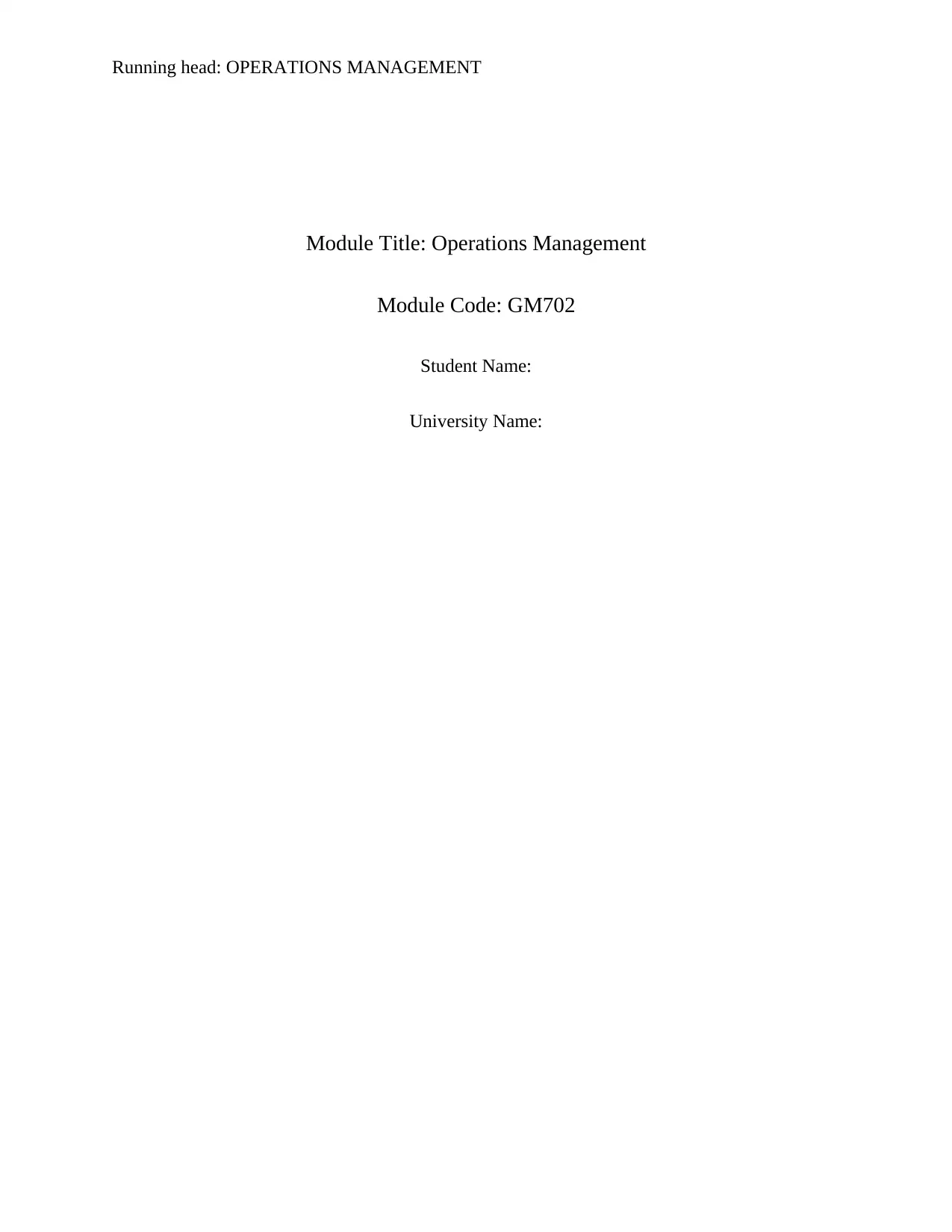
Running head: OPERATIONS MANAGEMENT
Module Title: Operations Management
Module Code: GM702
Student Name:
University Name:
Module Title: Operations Management
Module Code: GM702
Student Name:
University Name:
Paraphrase This Document
Need a fresh take? Get an instant paraphrase of this document with our AI Paraphraser
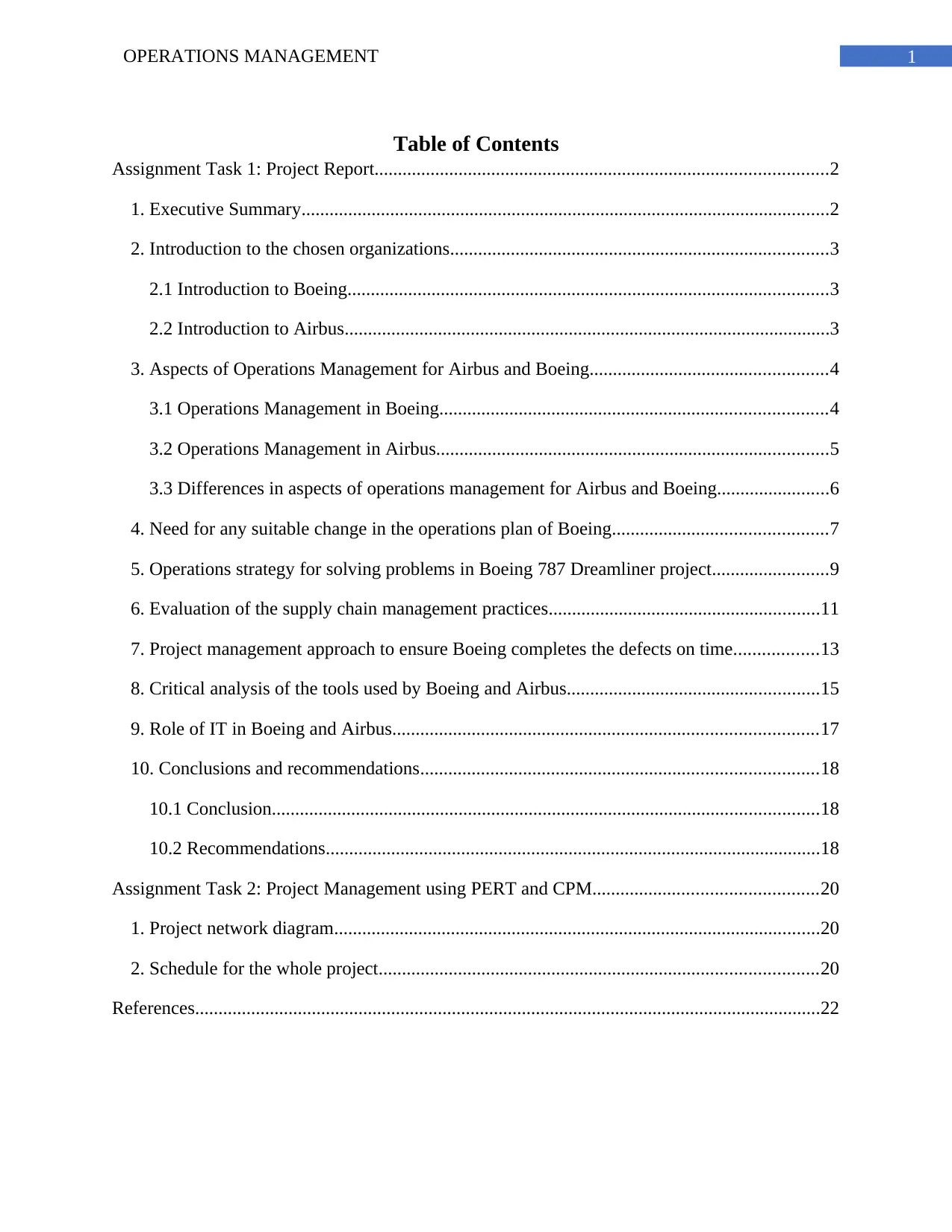
1OPERATIONS MANAGEMENT
Table of Contents
Assignment Task 1: Project Report.................................................................................................2
1. Executive Summary.................................................................................................................2
2. Introduction to the chosen organizations.................................................................................3
2.1 Introduction to Boeing.......................................................................................................3
2.2 Introduction to Airbus........................................................................................................3
3. Aspects of Operations Management for Airbus and Boeing...................................................4
3.1 Operations Management in Boeing...................................................................................4
3.2 Operations Management in Airbus....................................................................................5
3.3 Differences in aspects of operations management for Airbus and Boeing........................6
4. Need for any suitable change in the operations plan of Boeing..............................................7
5. Operations strategy for solving problems in Boeing 787 Dreamliner project.........................9
6. Evaluation of the supply chain management practices..........................................................11
7. Project management approach to ensure Boeing completes the defects on time..................13
8. Critical analysis of the tools used by Boeing and Airbus......................................................15
9. Role of IT in Boeing and Airbus...........................................................................................17
10. Conclusions and recommendations.....................................................................................18
10.1 Conclusion.....................................................................................................................18
10.2 Recommendations..........................................................................................................18
Assignment Task 2: Project Management using PERT and CPM................................................20
1. Project network diagram........................................................................................................20
2. Schedule for the whole project..............................................................................................20
References......................................................................................................................................22
Table of Contents
Assignment Task 1: Project Report.................................................................................................2
1. Executive Summary.................................................................................................................2
2. Introduction to the chosen organizations.................................................................................3
2.1 Introduction to Boeing.......................................................................................................3
2.2 Introduction to Airbus........................................................................................................3
3. Aspects of Operations Management for Airbus and Boeing...................................................4
3.1 Operations Management in Boeing...................................................................................4
3.2 Operations Management in Airbus....................................................................................5
3.3 Differences in aspects of operations management for Airbus and Boeing........................6
4. Need for any suitable change in the operations plan of Boeing..............................................7
5. Operations strategy for solving problems in Boeing 787 Dreamliner project.........................9
6. Evaluation of the supply chain management practices..........................................................11
7. Project management approach to ensure Boeing completes the defects on time..................13
8. Critical analysis of the tools used by Boeing and Airbus......................................................15
9. Role of IT in Boeing and Airbus...........................................................................................17
10. Conclusions and recommendations.....................................................................................18
10.1 Conclusion.....................................................................................................................18
10.2 Recommendations..........................................................................................................18
Assignment Task 2: Project Management using PERT and CPM................................................20
1. Project network diagram........................................................................................................20
2. Schedule for the whole project..............................................................................................20
References......................................................................................................................................22
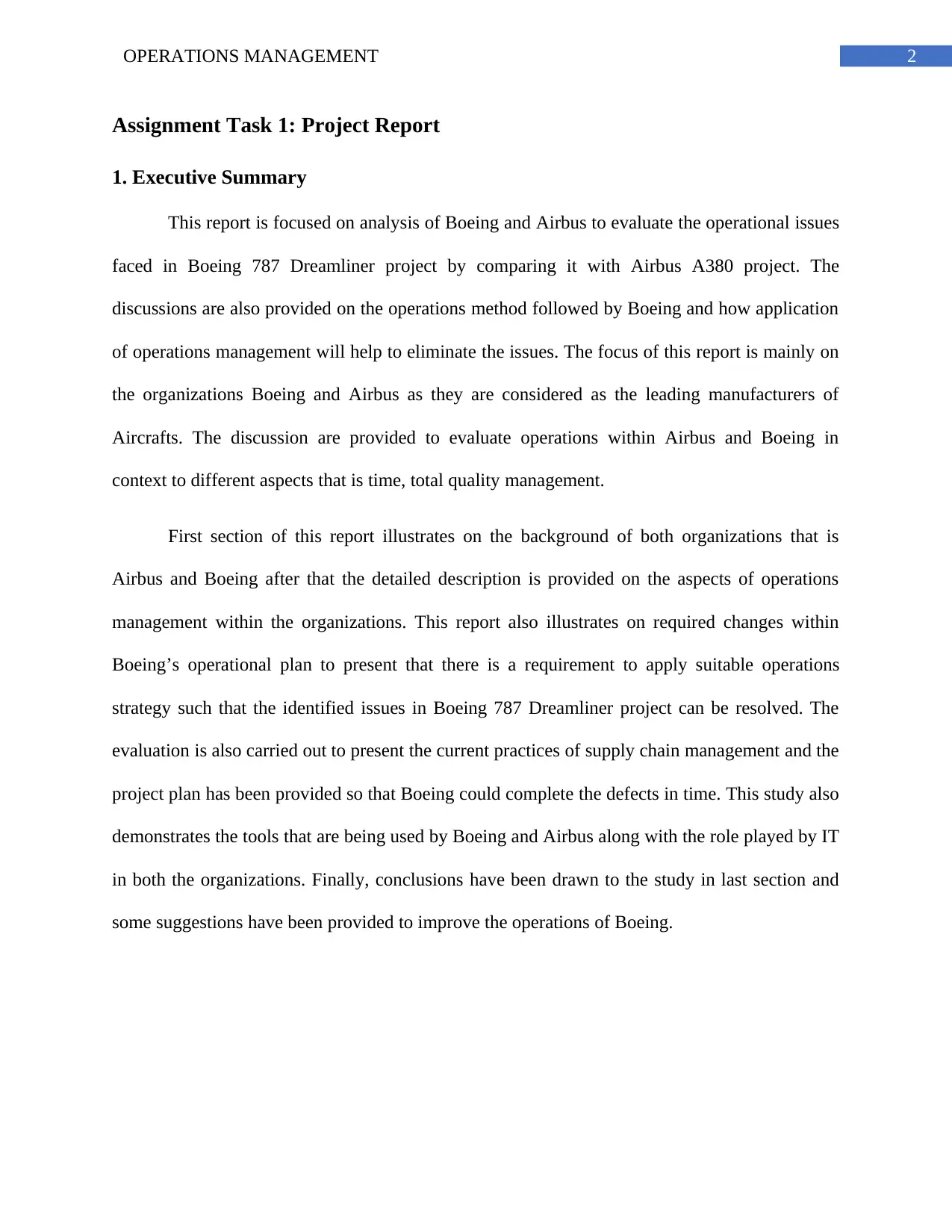
2OPERATIONS MANAGEMENT
Assignment Task 1: Project Report
1. Executive Summary
This report is focused on analysis of Boeing and Airbus to evaluate the operational issues
faced in Boeing 787 Dreamliner project by comparing it with Airbus A380 project. The
discussions are also provided on the operations method followed by Boeing and how application
of operations management will help to eliminate the issues. The focus of this report is mainly on
the organizations Boeing and Airbus as they are considered as the leading manufacturers of
Aircrafts. The discussion are provided to evaluate operations within Airbus and Boeing in
context to different aspects that is time, total quality management.
First section of this report illustrates on the background of both organizations that is
Airbus and Boeing after that the detailed description is provided on the aspects of operations
management within the organizations. This report also illustrates on required changes within
Boeing’s operational plan to present that there is a requirement to apply suitable operations
strategy such that the identified issues in Boeing 787 Dreamliner project can be resolved. The
evaluation is also carried out to present the current practices of supply chain management and the
project plan has been provided so that Boeing could complete the defects in time. This study also
demonstrates the tools that are being used by Boeing and Airbus along with the role played by IT
in both the organizations. Finally, conclusions have been drawn to the study in last section and
some suggestions have been provided to improve the operations of Boeing.
Assignment Task 1: Project Report
1. Executive Summary
This report is focused on analysis of Boeing and Airbus to evaluate the operational issues
faced in Boeing 787 Dreamliner project by comparing it with Airbus A380 project. The
discussions are also provided on the operations method followed by Boeing and how application
of operations management will help to eliminate the issues. The focus of this report is mainly on
the organizations Boeing and Airbus as they are considered as the leading manufacturers of
Aircrafts. The discussion are provided to evaluate operations within Airbus and Boeing in
context to different aspects that is time, total quality management.
First section of this report illustrates on the background of both organizations that is
Airbus and Boeing after that the detailed description is provided on the aspects of operations
management within the organizations. This report also illustrates on required changes within
Boeing’s operational plan to present that there is a requirement to apply suitable operations
strategy such that the identified issues in Boeing 787 Dreamliner project can be resolved. The
evaluation is also carried out to present the current practices of supply chain management and the
project plan has been provided so that Boeing could complete the defects in time. This study also
demonstrates the tools that are being used by Boeing and Airbus along with the role played by IT
in both the organizations. Finally, conclusions have been drawn to the study in last section and
some suggestions have been provided to improve the operations of Boeing.
⊘ This is a preview!⊘
Do you want full access?
Subscribe today to unlock all pages.

Trusted by 1+ million students worldwide
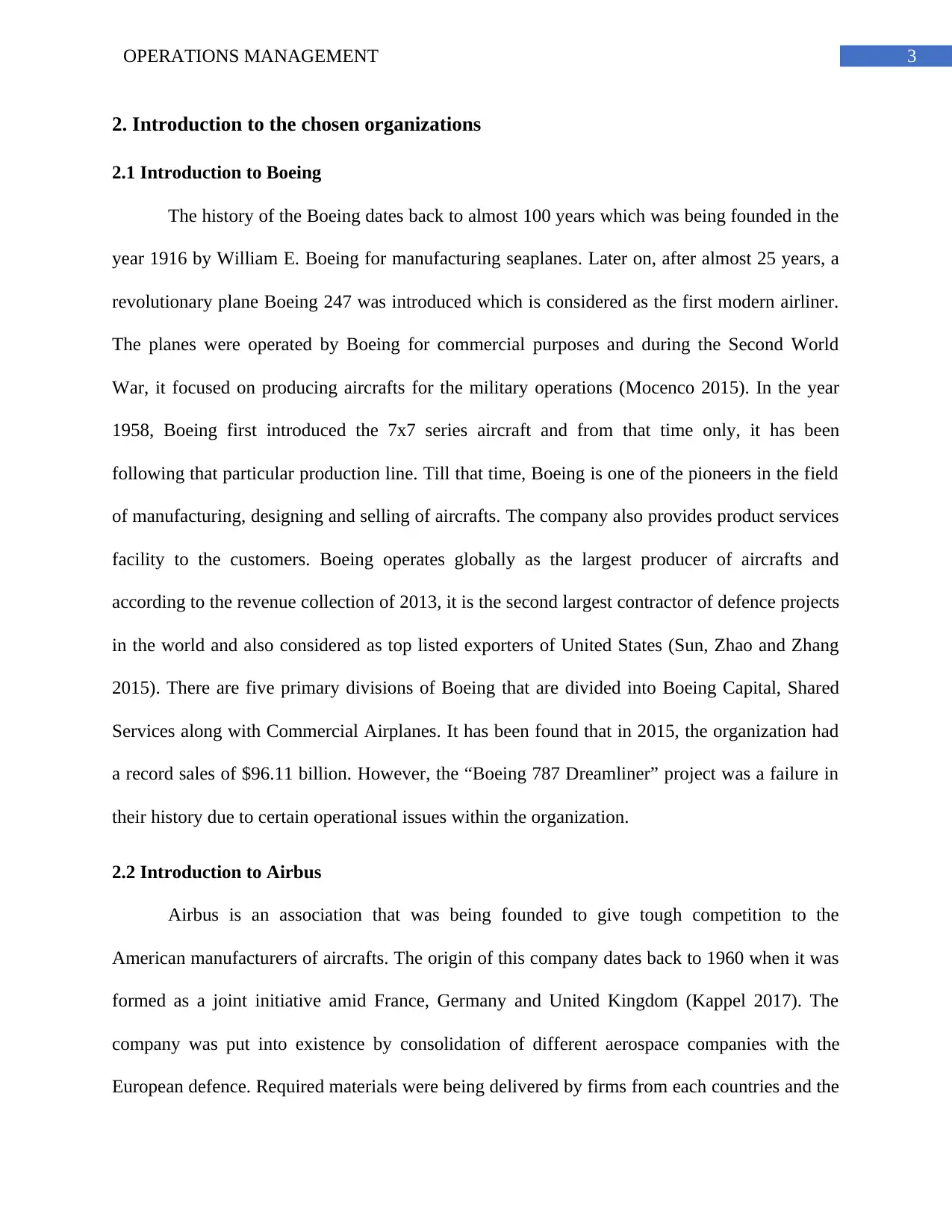
3OPERATIONS MANAGEMENT
2. Introduction to the chosen organizations
2.1 Introduction to Boeing
The history of the Boeing dates back to almost 100 years which was being founded in the
year 1916 by William E. Boeing for manufacturing seaplanes. Later on, after almost 25 years, a
revolutionary plane Boeing 247 was introduced which is considered as the first modern airliner.
The planes were operated by Boeing for commercial purposes and during the Second World
War, it focused on producing aircrafts for the military operations (Mocenco 2015). In the year
1958, Boeing first introduced the 7x7 series aircraft and from that time only, it has been
following that particular production line. Till that time, Boeing is one of the pioneers in the field
of manufacturing, designing and selling of aircrafts. The company also provides product services
facility to the customers. Boeing operates globally as the largest producer of aircrafts and
according to the revenue collection of 2013, it is the second largest contractor of defence projects
in the world and also considered as top listed exporters of United States (Sun, Zhao and Zhang
2015). There are five primary divisions of Boeing that are divided into Boeing Capital, Shared
Services along with Commercial Airplanes. It has been found that in 2015, the organization had
a record sales of $96.11 billion. However, the “Boeing 787 Dreamliner” project was a failure in
their history due to certain operational issues within the organization.
2.2 Introduction to Airbus
Airbus is an association that was being founded to give tough competition to the
American manufacturers of aircrafts. The origin of this company dates back to 1960 when it was
formed as a joint initiative amid France, Germany and United Kingdom (Kappel 2017). The
company was put into existence by consolidation of different aerospace companies with the
European defence. Required materials were being delivered by firms from each countries and the
2. Introduction to the chosen organizations
2.1 Introduction to Boeing
The history of the Boeing dates back to almost 100 years which was being founded in the
year 1916 by William E. Boeing for manufacturing seaplanes. Later on, after almost 25 years, a
revolutionary plane Boeing 247 was introduced which is considered as the first modern airliner.
The planes were operated by Boeing for commercial purposes and during the Second World
War, it focused on producing aircrafts for the military operations (Mocenco 2015). In the year
1958, Boeing first introduced the 7x7 series aircraft and from that time only, it has been
following that particular production line. Till that time, Boeing is one of the pioneers in the field
of manufacturing, designing and selling of aircrafts. The company also provides product services
facility to the customers. Boeing operates globally as the largest producer of aircrafts and
according to the revenue collection of 2013, it is the second largest contractor of defence projects
in the world and also considered as top listed exporters of United States (Sun, Zhao and Zhang
2015). There are five primary divisions of Boeing that are divided into Boeing Capital, Shared
Services along with Commercial Airplanes. It has been found that in 2015, the organization had
a record sales of $96.11 billion. However, the “Boeing 787 Dreamliner” project was a failure in
their history due to certain operational issues within the organization.
2.2 Introduction to Airbus
Airbus is an association that was being founded to give tough competition to the
American manufacturers of aircrafts. The origin of this company dates back to 1960 when it was
formed as a joint initiative amid France, Germany and United Kingdom (Kappel 2017). The
company was put into existence by consolidation of different aerospace companies with the
European defence. Required materials were being delivered by firms from each countries and the
Paraphrase This Document
Need a fresh take? Get an instant paraphrase of this document with our AI Paraphraser
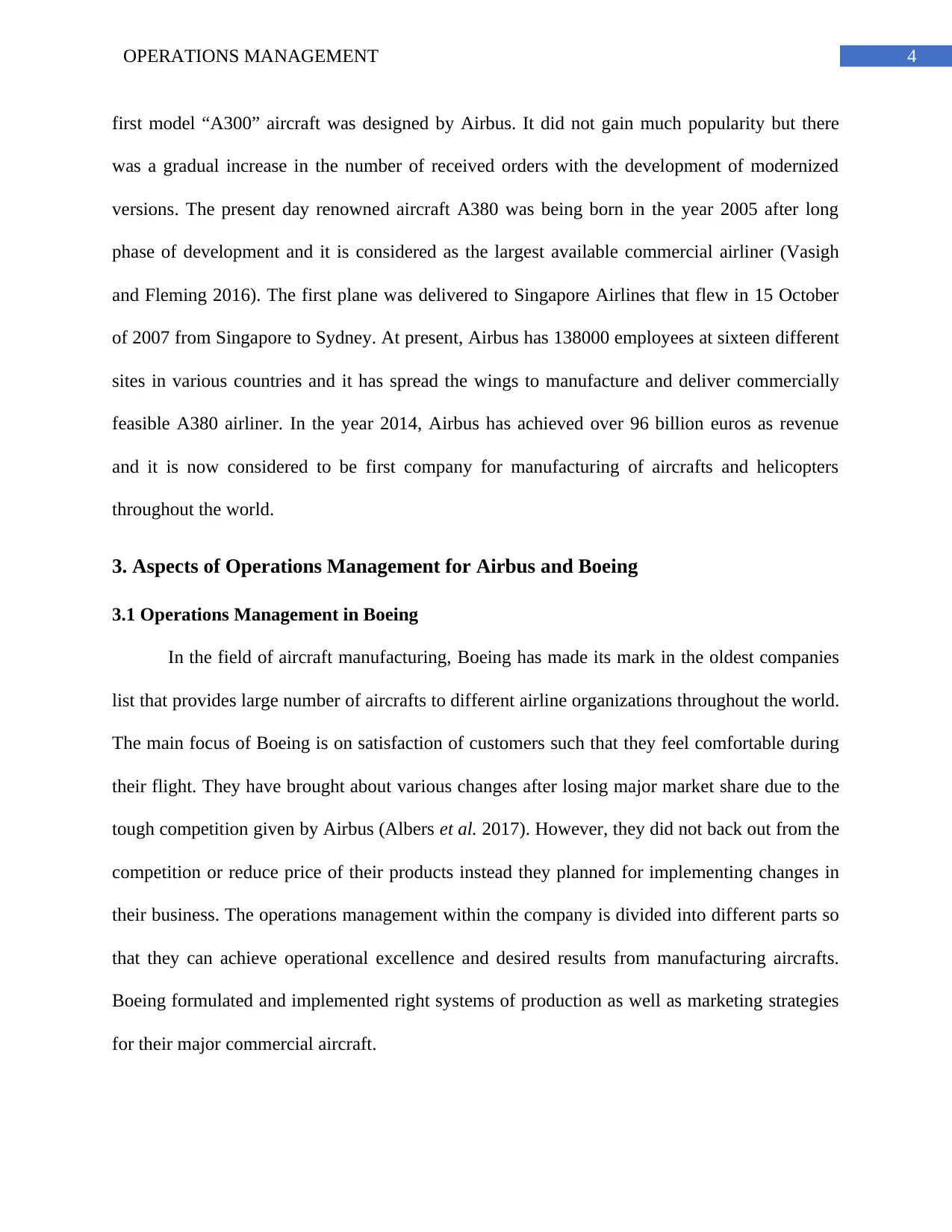
4OPERATIONS MANAGEMENT
first model “A300” aircraft was designed by Airbus. It did not gain much popularity but there
was a gradual increase in the number of received orders with the development of modernized
versions. The present day renowned aircraft A380 was being born in the year 2005 after long
phase of development and it is considered as the largest available commercial airliner (Vasigh
and Fleming 2016). The first plane was delivered to Singapore Airlines that flew in 15 October
of 2007 from Singapore to Sydney. At present, Airbus has 138000 employees at sixteen different
sites in various countries and it has spread the wings to manufacture and deliver commercially
feasible A380 airliner. In the year 2014, Airbus has achieved over 96 billion euros as revenue
and it is now considered to be first company for manufacturing of aircrafts and helicopters
throughout the world.
3. Aspects of Operations Management for Airbus and Boeing
3.1 Operations Management in Boeing
In the field of aircraft manufacturing, Boeing has made its mark in the oldest companies
list that provides large number of aircrafts to different airline organizations throughout the world.
The main focus of Boeing is on satisfaction of customers such that they feel comfortable during
their flight. They have brought about various changes after losing major market share due to the
tough competition given by Airbus (Albers et al. 2017). However, they did not back out from the
competition or reduce price of their products instead they planned for implementing changes in
their business. The operations management within the company is divided into different parts so
that they can achieve operational excellence and desired results from manufacturing aircrafts.
Boeing formulated and implemented right systems of production as well as marketing strategies
for their major commercial aircraft.
first model “A300” aircraft was designed by Airbus. It did not gain much popularity but there
was a gradual increase in the number of received orders with the development of modernized
versions. The present day renowned aircraft A380 was being born in the year 2005 after long
phase of development and it is considered as the largest available commercial airliner (Vasigh
and Fleming 2016). The first plane was delivered to Singapore Airlines that flew in 15 October
of 2007 from Singapore to Sydney. At present, Airbus has 138000 employees at sixteen different
sites in various countries and it has spread the wings to manufacture and deliver commercially
feasible A380 airliner. In the year 2014, Airbus has achieved over 96 billion euros as revenue
and it is now considered to be first company for manufacturing of aircrafts and helicopters
throughout the world.
3. Aspects of Operations Management for Airbus and Boeing
3.1 Operations Management in Boeing
In the field of aircraft manufacturing, Boeing has made its mark in the oldest companies
list that provides large number of aircrafts to different airline organizations throughout the world.
The main focus of Boeing is on satisfaction of customers such that they feel comfortable during
their flight. They have brought about various changes after losing major market share due to the
tough competition given by Airbus (Albers et al. 2017). However, they did not back out from the
competition or reduce price of their products instead they planned for implementing changes in
their business. The operations management within the company is divided into different parts so
that they can achieve operational excellence and desired results from manufacturing aircrafts.
Boeing formulated and implemented right systems of production as well as marketing strategies
for their major commercial aircraft.
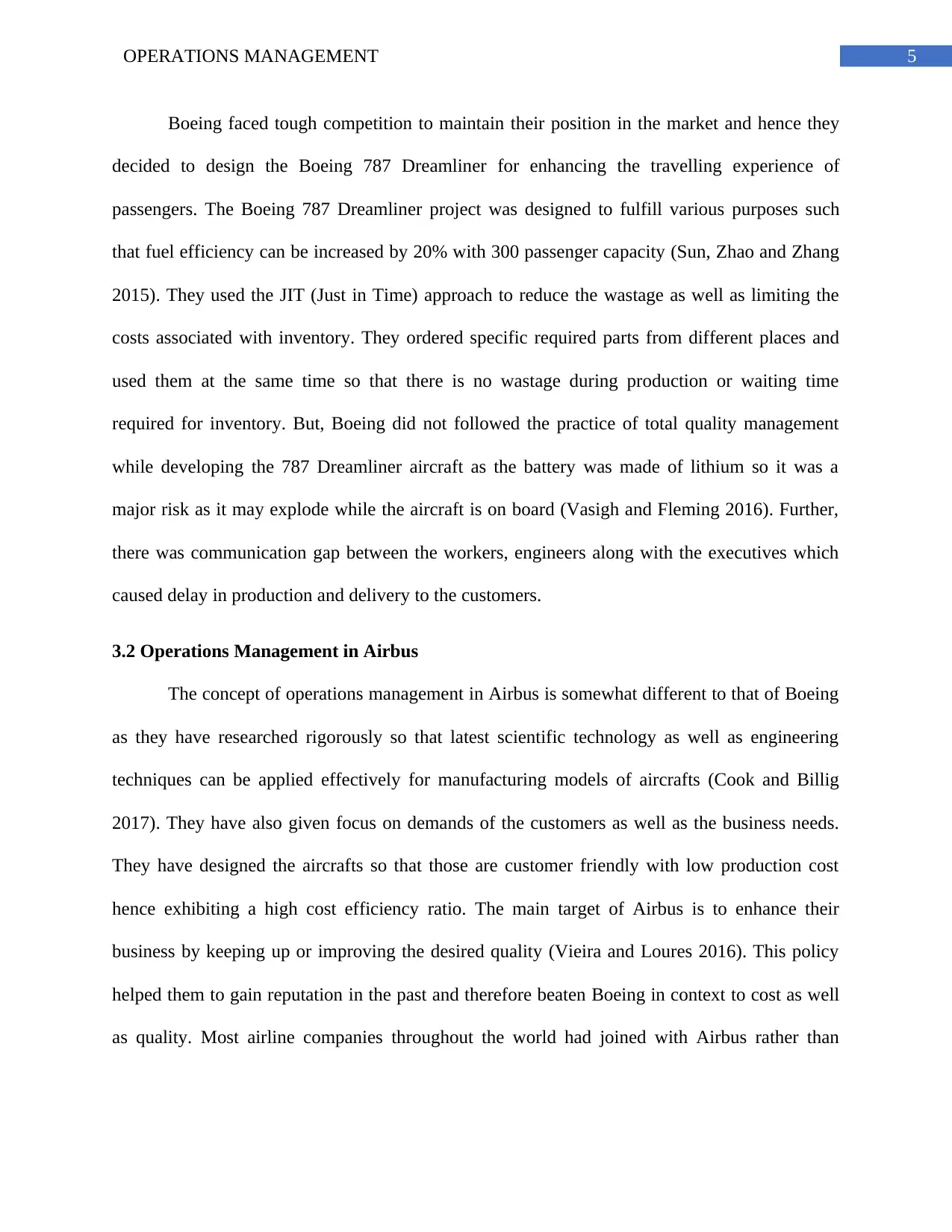
5OPERATIONS MANAGEMENT
Boeing faced tough competition to maintain their position in the market and hence they
decided to design the Boeing 787 Dreamliner for enhancing the travelling experience of
passengers. The Boeing 787 Dreamliner project was designed to fulfill various purposes such
that fuel efficiency can be increased by 20% with 300 passenger capacity (Sun, Zhao and Zhang
2015). They used the JIT (Just in Time) approach to reduce the wastage as well as limiting the
costs associated with inventory. They ordered specific required parts from different places and
used them at the same time so that there is no wastage during production or waiting time
required for inventory. But, Boeing did not followed the practice of total quality management
while developing the 787 Dreamliner aircraft as the battery was made of lithium so it was a
major risk as it may explode while the aircraft is on board (Vasigh and Fleming 2016). Further,
there was communication gap between the workers, engineers along with the executives which
caused delay in production and delivery to the customers.
3.2 Operations Management in Airbus
The concept of operations management in Airbus is somewhat different to that of Boeing
as they have researched rigorously so that latest scientific technology as well as engineering
techniques can be applied effectively for manufacturing models of aircrafts (Cook and Billig
2017). They have also given focus on demands of the customers as well as the business needs.
They have designed the aircrafts so that those are customer friendly with low production cost
hence exhibiting a high cost efficiency ratio. The main target of Airbus is to enhance their
business by keeping up or improving the desired quality (Vieira and Loures 2016). This policy
helped them to gain reputation in the past and therefore beaten Boeing in context to cost as well
as quality. Most airline companies throughout the world had joined with Airbus rather than
Boeing faced tough competition to maintain their position in the market and hence they
decided to design the Boeing 787 Dreamliner for enhancing the travelling experience of
passengers. The Boeing 787 Dreamliner project was designed to fulfill various purposes such
that fuel efficiency can be increased by 20% with 300 passenger capacity (Sun, Zhao and Zhang
2015). They used the JIT (Just in Time) approach to reduce the wastage as well as limiting the
costs associated with inventory. They ordered specific required parts from different places and
used them at the same time so that there is no wastage during production or waiting time
required for inventory. But, Boeing did not followed the practice of total quality management
while developing the 787 Dreamliner aircraft as the battery was made of lithium so it was a
major risk as it may explode while the aircraft is on board (Vasigh and Fleming 2016). Further,
there was communication gap between the workers, engineers along with the executives which
caused delay in production and delivery to the customers.
3.2 Operations Management in Airbus
The concept of operations management in Airbus is somewhat different to that of Boeing
as they have researched rigorously so that latest scientific technology as well as engineering
techniques can be applied effectively for manufacturing models of aircrafts (Cook and Billig
2017). They have also given focus on demands of the customers as well as the business needs.
They have designed the aircrafts so that those are customer friendly with low production cost
hence exhibiting a high cost efficiency ratio. The main target of Airbus is to enhance their
business by keeping up or improving the desired quality (Vieira and Loures 2016). This policy
helped them to gain reputation in the past and therefore beaten Boeing in context to cost as well
as quality. Most airline companies throughout the world had joined with Airbus rather than
⊘ This is a preview!⊘
Do you want full access?
Subscribe today to unlock all pages.

Trusted by 1+ million students worldwide
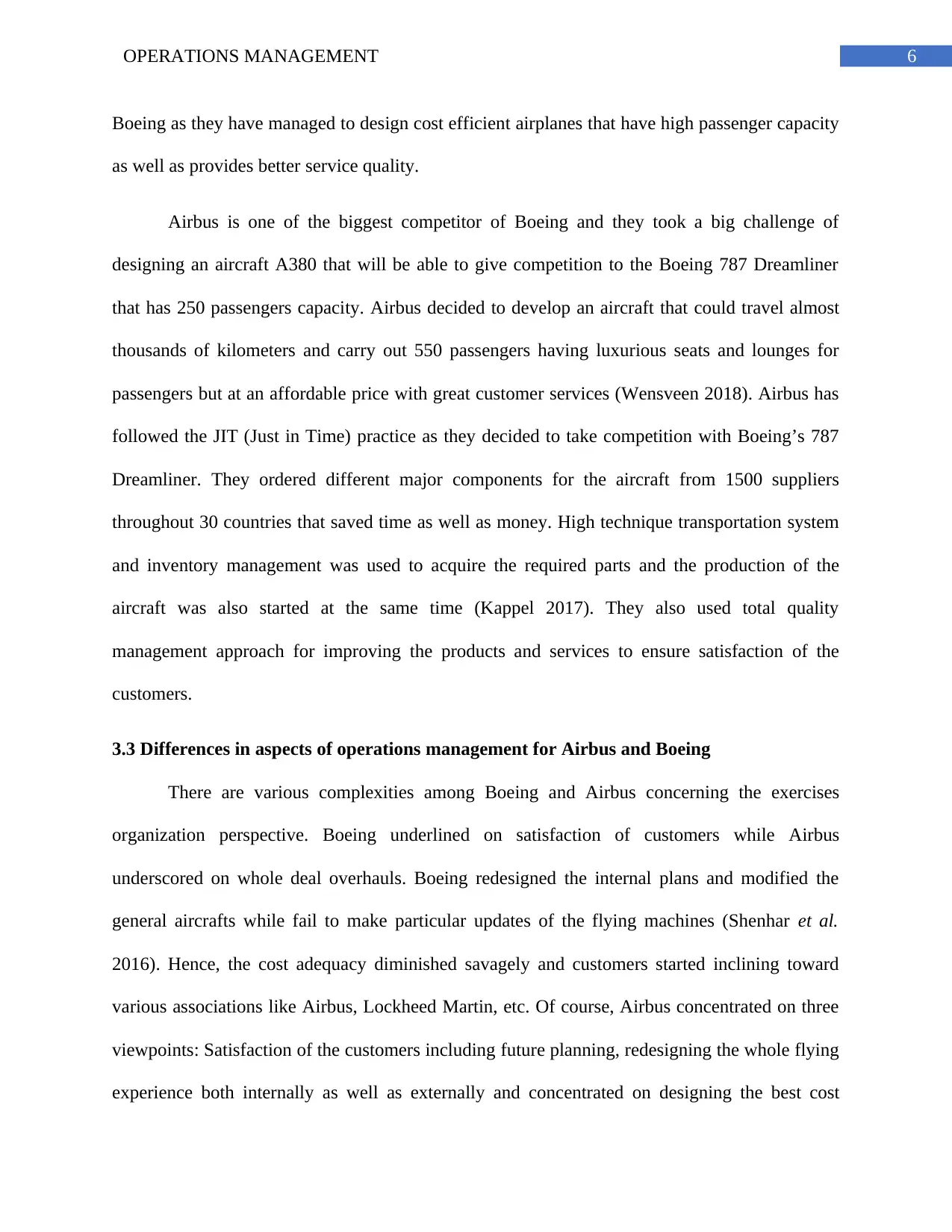
6OPERATIONS MANAGEMENT
Boeing as they have managed to design cost efficient airplanes that have high passenger capacity
as well as provides better service quality.
Airbus is one of the biggest competitor of Boeing and they took a big challenge of
designing an aircraft A380 that will be able to give competition to the Boeing 787 Dreamliner
that has 250 passengers capacity. Airbus decided to develop an aircraft that could travel almost
thousands of kilometers and carry out 550 passengers having luxurious seats and lounges for
passengers but at an affordable price with great customer services (Wensveen 2018). Airbus has
followed the JIT (Just in Time) practice as they decided to take competition with Boeing’s 787
Dreamliner. They ordered different major components for the aircraft from 1500 suppliers
throughout 30 countries that saved time as well as money. High technique transportation system
and inventory management was used to acquire the required parts and the production of the
aircraft was also started at the same time (Kappel 2017). They also used total quality
management approach for improving the products and services to ensure satisfaction of the
customers.
3.3 Differences in aspects of operations management for Airbus and Boeing
There are various complexities among Boeing and Airbus concerning the exercises
organization perspective. Boeing underlined on satisfaction of customers while Airbus
underscored on whole deal overhauls. Boeing redesigned the internal plans and modified the
general aircrafts while fail to make particular updates of the flying machines (Shenhar et al.
2016). Hence, the cost adequacy diminished savagely and customers started inclining toward
various associations like Airbus, Lockheed Martin, etc. Of course, Airbus concentrated on three
viewpoints: Satisfaction of the customers including future planning, redesigning the whole flying
experience both internally as well as externally and concentrated on designing the best cost
Boeing as they have managed to design cost efficient airplanes that have high passenger capacity
as well as provides better service quality.
Airbus is one of the biggest competitor of Boeing and they took a big challenge of
designing an aircraft A380 that will be able to give competition to the Boeing 787 Dreamliner
that has 250 passengers capacity. Airbus decided to develop an aircraft that could travel almost
thousands of kilometers and carry out 550 passengers having luxurious seats and lounges for
passengers but at an affordable price with great customer services (Wensveen 2018). Airbus has
followed the JIT (Just in Time) practice as they decided to take competition with Boeing’s 787
Dreamliner. They ordered different major components for the aircraft from 1500 suppliers
throughout 30 countries that saved time as well as money. High technique transportation system
and inventory management was used to acquire the required parts and the production of the
aircraft was also started at the same time (Kappel 2017). They also used total quality
management approach for improving the products and services to ensure satisfaction of the
customers.
3.3 Differences in aspects of operations management for Airbus and Boeing
There are various complexities among Boeing and Airbus concerning the exercises
organization perspective. Boeing underlined on satisfaction of customers while Airbus
underscored on whole deal overhauls. Boeing redesigned the internal plans and modified the
general aircrafts while fail to make particular updates of the flying machines (Shenhar et al.
2016). Hence, the cost adequacy diminished savagely and customers started inclining toward
various associations like Airbus, Lockheed Martin, etc. Of course, Airbus concentrated on three
viewpoints: Satisfaction of the customers including future planning, redesigning the whole flying
experience both internally as well as externally and concentrated on designing the best cost
Paraphrase This Document
Need a fresh take? Get an instant paraphrase of this document with our AI Paraphraser
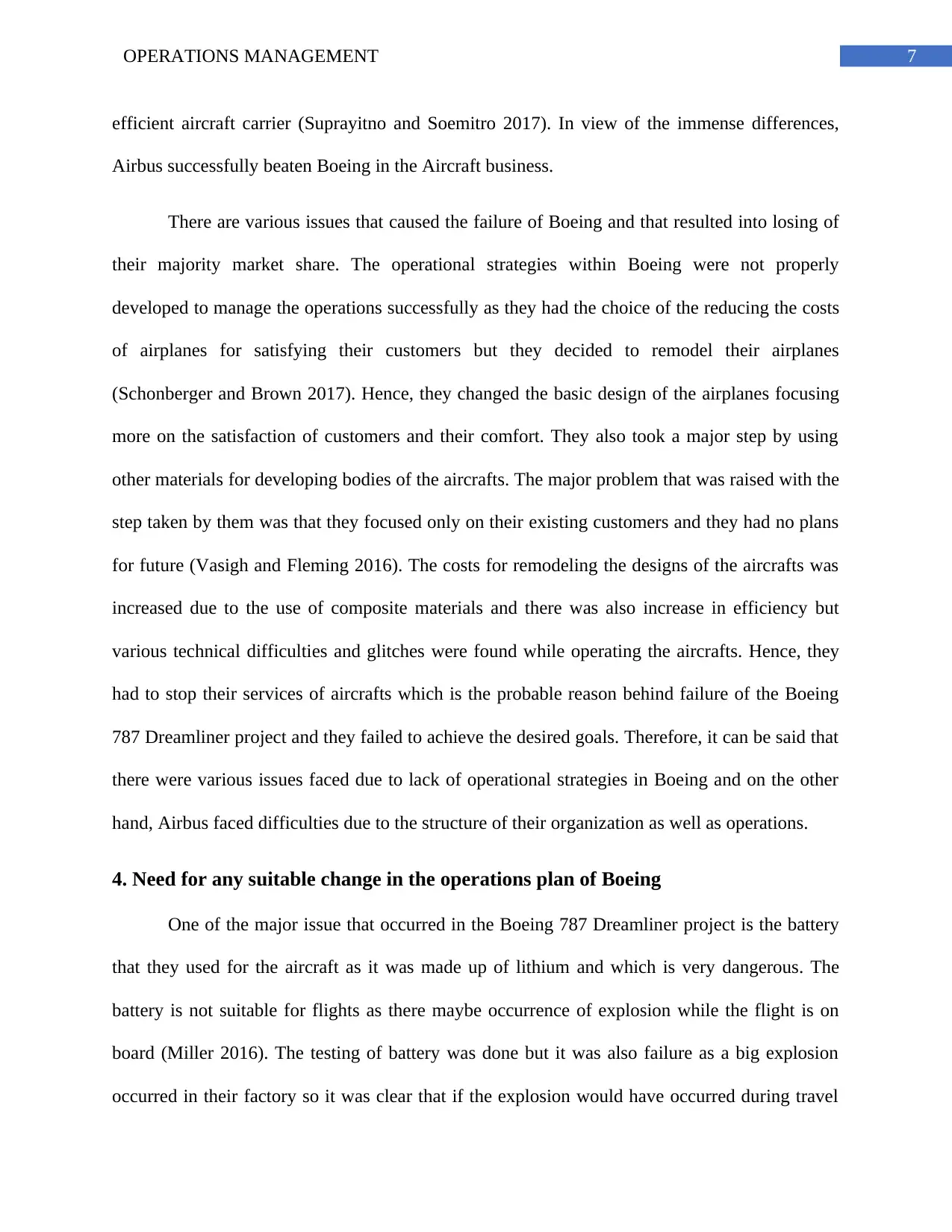
7OPERATIONS MANAGEMENT
efficient aircraft carrier (Suprayitno and Soemitro 2017). In view of the immense differences,
Airbus successfully beaten Boeing in the Aircraft business.
There are various issues that caused the failure of Boeing and that resulted into losing of
their majority market share. The operational strategies within Boeing were not properly
developed to manage the operations successfully as they had the choice of the reducing the costs
of airplanes for satisfying their customers but they decided to remodel their airplanes
(Schonberger and Brown 2017). Hence, they changed the basic design of the airplanes focusing
more on the satisfaction of customers and their comfort. They also took a major step by using
other materials for developing bodies of the aircrafts. The major problem that was raised with the
step taken by them was that they focused only on their existing customers and they had no plans
for future (Vasigh and Fleming 2016). The costs for remodeling the designs of the aircrafts was
increased due to the use of composite materials and there was also increase in efficiency but
various technical difficulties and glitches were found while operating the aircrafts. Hence, they
had to stop their services of aircrafts which is the probable reason behind failure of the Boeing
787 Dreamliner project and they failed to achieve the desired goals. Therefore, it can be said that
there were various issues faced due to lack of operational strategies in Boeing and on the other
hand, Airbus faced difficulties due to the structure of their organization as well as operations.
4. Need for any suitable change in the operations plan of Boeing
One of the major issue that occurred in the Boeing 787 Dreamliner project is the battery
that they used for the aircraft as it was made up of lithium and which is very dangerous. The
battery is not suitable for flights as there maybe occurrence of explosion while the flight is on
board (Miller 2016). The testing of battery was done but it was also failure as a big explosion
occurred in their factory so it was clear that if the explosion would have occurred during travel
efficient aircraft carrier (Suprayitno and Soemitro 2017). In view of the immense differences,
Airbus successfully beaten Boeing in the Aircraft business.
There are various issues that caused the failure of Boeing and that resulted into losing of
their majority market share. The operational strategies within Boeing were not properly
developed to manage the operations successfully as they had the choice of the reducing the costs
of airplanes for satisfying their customers but they decided to remodel their airplanes
(Schonberger and Brown 2017). Hence, they changed the basic design of the airplanes focusing
more on the satisfaction of customers and their comfort. They also took a major step by using
other materials for developing bodies of the aircrafts. The major problem that was raised with the
step taken by them was that they focused only on their existing customers and they had no plans
for future (Vasigh and Fleming 2016). The costs for remodeling the designs of the aircrafts was
increased due to the use of composite materials and there was also increase in efficiency but
various technical difficulties and glitches were found while operating the aircrafts. Hence, they
had to stop their services of aircrafts which is the probable reason behind failure of the Boeing
787 Dreamliner project and they failed to achieve the desired goals. Therefore, it can be said that
there were various issues faced due to lack of operational strategies in Boeing and on the other
hand, Airbus faced difficulties due to the structure of their organization as well as operations.
4. Need for any suitable change in the operations plan of Boeing
One of the major issue that occurred in the Boeing 787 Dreamliner project is the battery
that they used for the aircraft as it was made up of lithium and which is very dangerous. The
battery is not suitable for flights as there maybe occurrence of explosion while the flight is on
board (Miller 2016). The testing of battery was done but it was also failure as a big explosion
occurred in their factory so it was clear that if the explosion would have occurred during travel
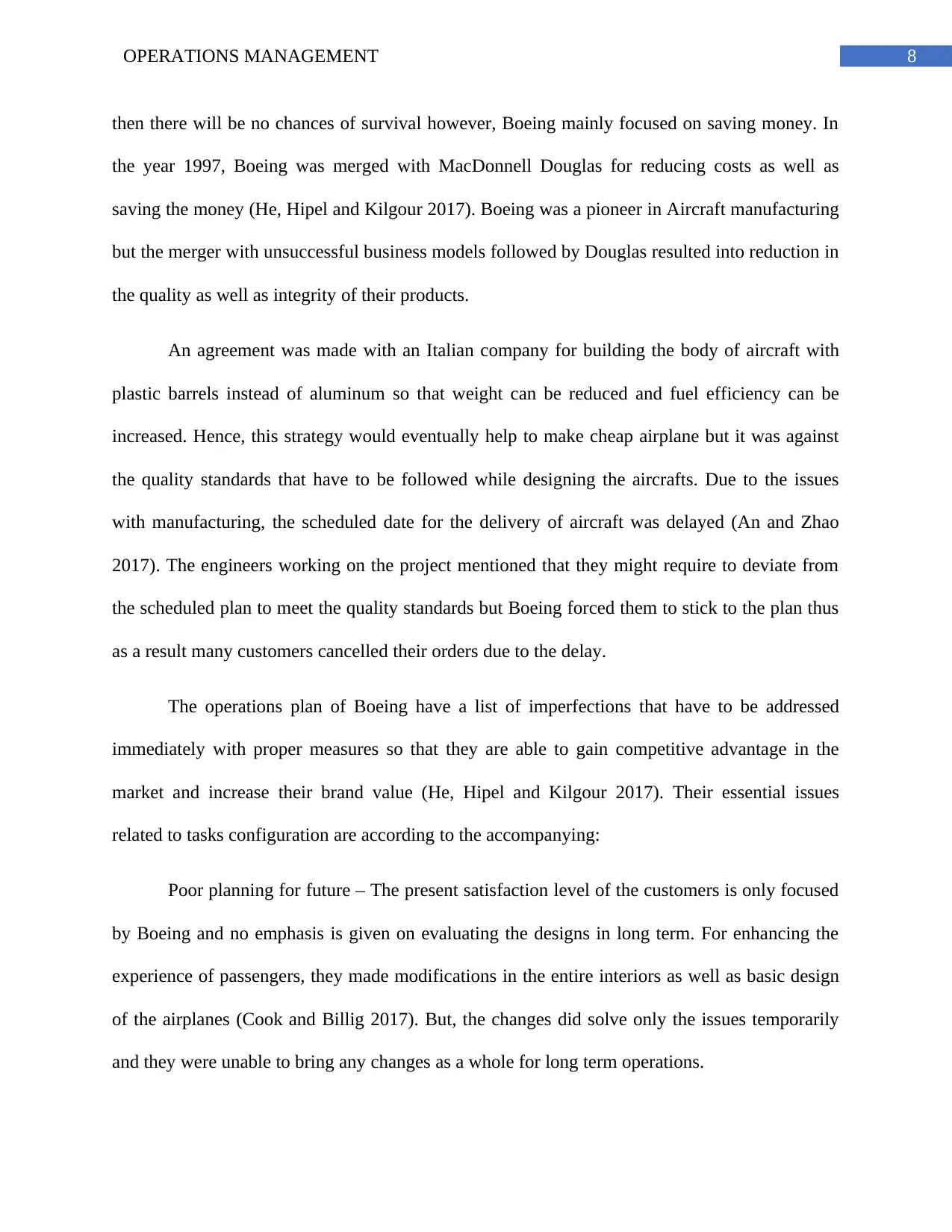
8OPERATIONS MANAGEMENT
then there will be no chances of survival however, Boeing mainly focused on saving money. In
the year 1997, Boeing was merged with MacDonnell Douglas for reducing costs as well as
saving the money (He, Hipel and Kilgour 2017). Boeing was a pioneer in Aircraft manufacturing
but the merger with unsuccessful business models followed by Douglas resulted into reduction in
the quality as well as integrity of their products.
An agreement was made with an Italian company for building the body of aircraft with
plastic barrels instead of aluminum so that weight can be reduced and fuel efficiency can be
increased. Hence, this strategy would eventually help to make cheap airplane but it was against
the quality standards that have to be followed while designing the aircrafts. Due to the issues
with manufacturing, the scheduled date for the delivery of aircraft was delayed (An and Zhao
2017). The engineers working on the project mentioned that they might require to deviate from
the scheduled plan to meet the quality standards but Boeing forced them to stick to the plan thus
as a result many customers cancelled their orders due to the delay.
The operations plan of Boeing have a list of imperfections that have to be addressed
immediately with proper measures so that they are able to gain competitive advantage in the
market and increase their brand value (He, Hipel and Kilgour 2017). Their essential issues
related to tasks configuration are according to the accompanying:
Poor planning for future – The present satisfaction level of the customers is only focused
by Boeing and no emphasis is given on evaluating the designs in long term. For enhancing the
experience of passengers, they made modifications in the entire interiors as well as basic design
of the airplanes (Cook and Billig 2017). But, the changes did solve only the issues temporarily
and they were unable to bring any changes as a whole for long term operations.
then there will be no chances of survival however, Boeing mainly focused on saving money. In
the year 1997, Boeing was merged with MacDonnell Douglas for reducing costs as well as
saving the money (He, Hipel and Kilgour 2017). Boeing was a pioneer in Aircraft manufacturing
but the merger with unsuccessful business models followed by Douglas resulted into reduction in
the quality as well as integrity of their products.
An agreement was made with an Italian company for building the body of aircraft with
plastic barrels instead of aluminum so that weight can be reduced and fuel efficiency can be
increased. Hence, this strategy would eventually help to make cheap airplane but it was against
the quality standards that have to be followed while designing the aircrafts. Due to the issues
with manufacturing, the scheduled date for the delivery of aircraft was delayed (An and Zhao
2017). The engineers working on the project mentioned that they might require to deviate from
the scheduled plan to meet the quality standards but Boeing forced them to stick to the plan thus
as a result many customers cancelled their orders due to the delay.
The operations plan of Boeing have a list of imperfections that have to be addressed
immediately with proper measures so that they are able to gain competitive advantage in the
market and increase their brand value (He, Hipel and Kilgour 2017). Their essential issues
related to tasks configuration are according to the accompanying:
Poor planning for future – The present satisfaction level of the customers is only focused
by Boeing and no emphasis is given on evaluating the designs in long term. For enhancing the
experience of passengers, they made modifications in the entire interiors as well as basic design
of the airplanes (Cook and Billig 2017). But, the changes did solve only the issues temporarily
and they were unable to bring any changes as a whole for long term operations.
⊘ This is a preview!⊘
Do you want full access?
Subscribe today to unlock all pages.

Trusted by 1+ million students worldwide
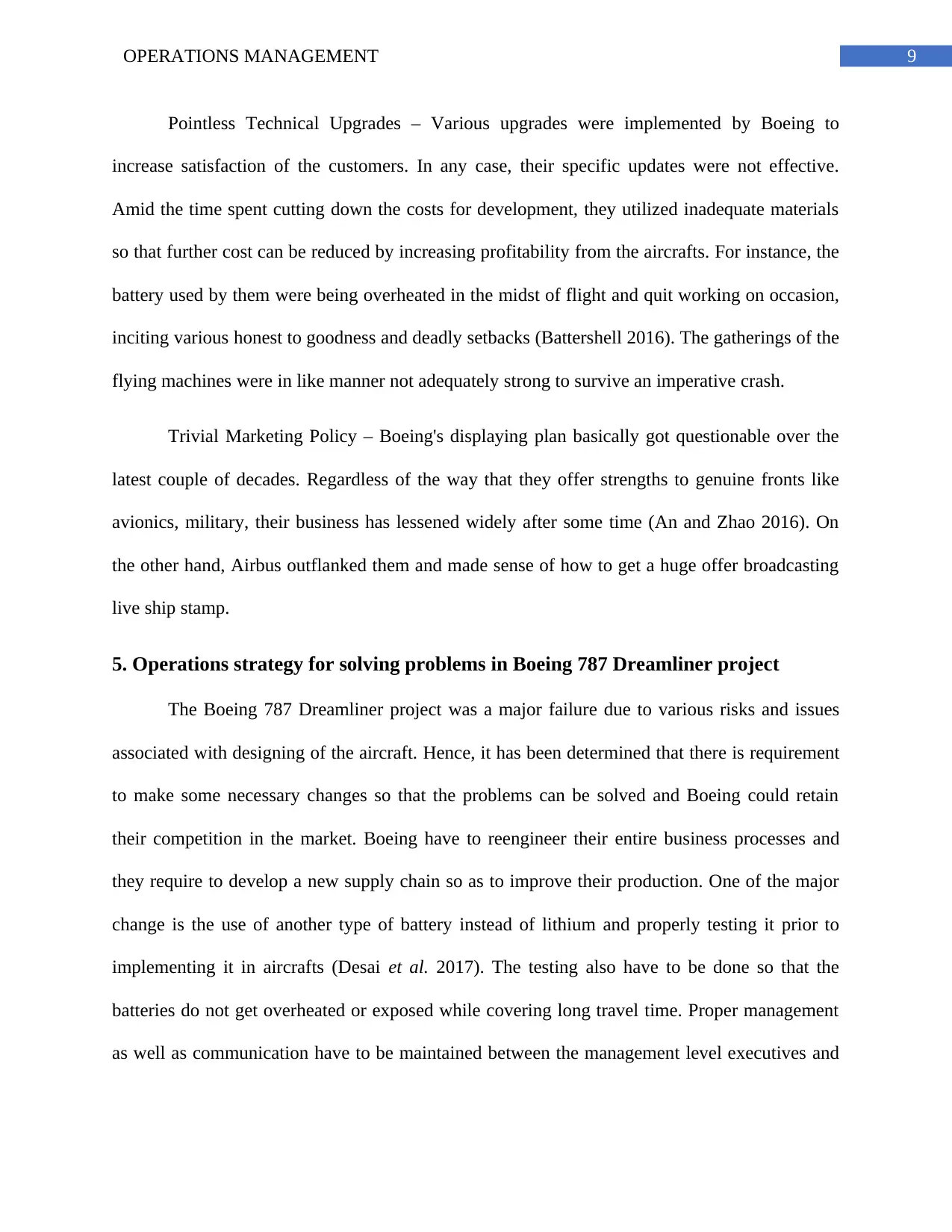
9OPERATIONS MANAGEMENT
Pointless Technical Upgrades – Various upgrades were implemented by Boeing to
increase satisfaction of the customers. In any case, their specific updates were not effective.
Amid the time spent cutting down the costs for development, they utilized inadequate materials
so that further cost can be reduced by increasing profitability from the aircrafts. For instance, the
battery used by them were being overheated in the midst of flight and quit working on occasion,
inciting various honest to goodness and deadly setbacks (Battershell 2016). The gatherings of the
flying machines were in like manner not adequately strong to survive an imperative crash.
Trivial Marketing Policy – Boeing's displaying plan basically got questionable over the
latest couple of decades. Regardless of the way that they offer strengths to genuine fronts like
avionics, military, their business has lessened widely after some time (An and Zhao 2016). On
the other hand, Airbus outflanked them and made sense of how to get a huge offer broadcasting
live ship stamp.
5. Operations strategy for solving problems in Boeing 787 Dreamliner project
The Boeing 787 Dreamliner project was a major failure due to various risks and issues
associated with designing of the aircraft. Hence, it has been determined that there is requirement
to make some necessary changes so that the problems can be solved and Boeing could retain
their competition in the market. Boeing have to reengineer their entire business processes and
they require to develop a new supply chain so as to improve their production. One of the major
change is the use of another type of battery instead of lithium and properly testing it prior to
implementing it in aircrafts (Desai et al. 2017). The testing also have to be done so that the
batteries do not get overheated or exposed while covering long travel time. Proper management
as well as communication have to be maintained between the management level executives and
Pointless Technical Upgrades – Various upgrades were implemented by Boeing to
increase satisfaction of the customers. In any case, their specific updates were not effective.
Amid the time spent cutting down the costs for development, they utilized inadequate materials
so that further cost can be reduced by increasing profitability from the aircrafts. For instance, the
battery used by them were being overheated in the midst of flight and quit working on occasion,
inciting various honest to goodness and deadly setbacks (Battershell 2016). The gatherings of the
flying machines were in like manner not adequately strong to survive an imperative crash.
Trivial Marketing Policy – Boeing's displaying plan basically got questionable over the
latest couple of decades. Regardless of the way that they offer strengths to genuine fronts like
avionics, military, their business has lessened widely after some time (An and Zhao 2016). On
the other hand, Airbus outflanked them and made sense of how to get a huge offer broadcasting
live ship stamp.
5. Operations strategy for solving problems in Boeing 787 Dreamliner project
The Boeing 787 Dreamliner project was a major failure due to various risks and issues
associated with designing of the aircraft. Hence, it has been determined that there is requirement
to make some necessary changes so that the problems can be solved and Boeing could retain
their competition in the market. Boeing have to reengineer their entire business processes and
they require to develop a new supply chain so as to improve their production. One of the major
change is the use of another type of battery instead of lithium and properly testing it prior to
implementing it in aircrafts (Desai et al. 2017). The testing also have to be done so that the
batteries do not get overheated or exposed while covering long travel time. Proper management
as well as communication have to be maintained between the management level executives and
Paraphrase This Document
Need a fresh take? Get an instant paraphrase of this document with our AI Paraphraser
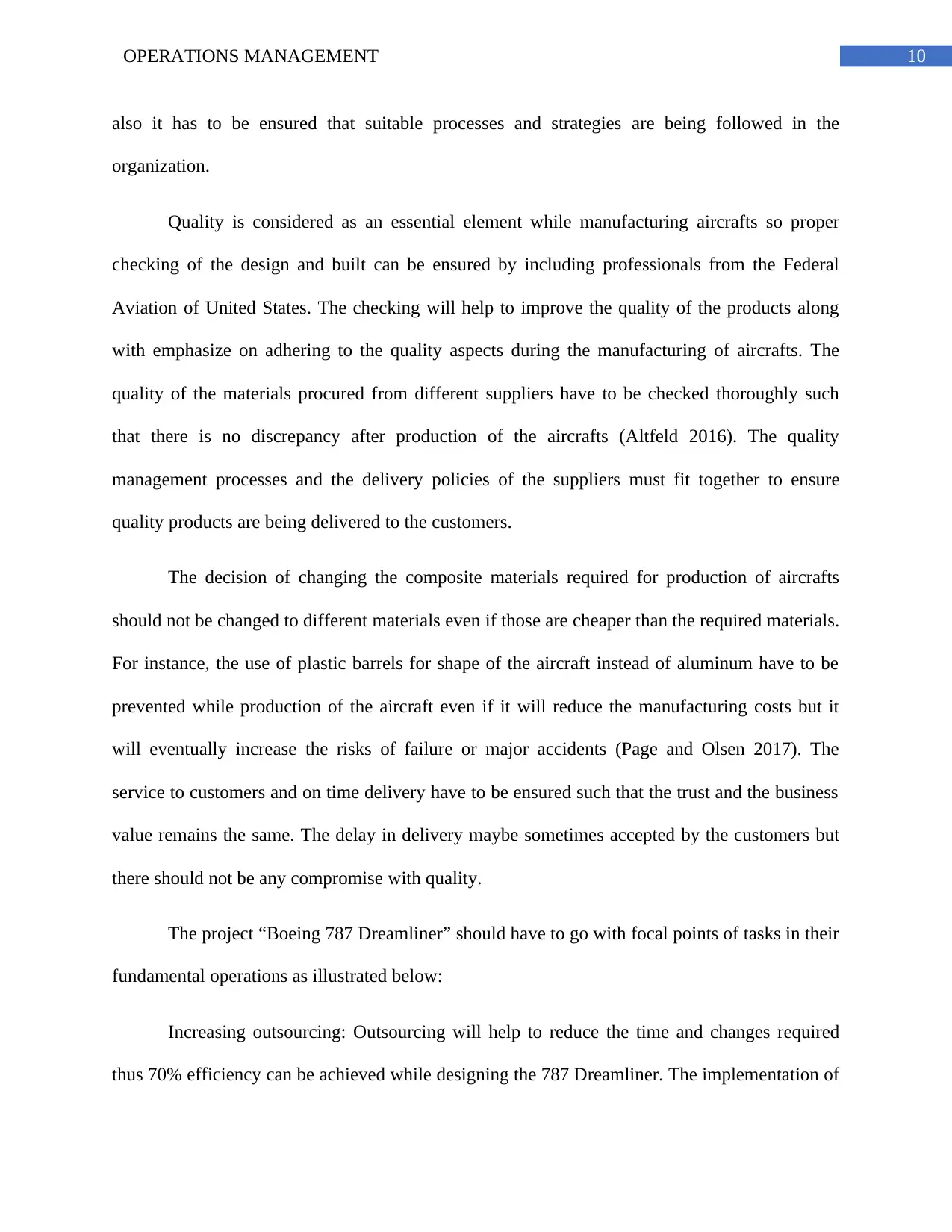
10OPERATIONS MANAGEMENT
also it has to be ensured that suitable processes and strategies are being followed in the
organization.
Quality is considered as an essential element while manufacturing aircrafts so proper
checking of the design and built can be ensured by including professionals from the Federal
Aviation of United States. The checking will help to improve the quality of the products along
with emphasize on adhering to the quality aspects during the manufacturing of aircrafts. The
quality of the materials procured from different suppliers have to be checked thoroughly such
that there is no discrepancy after production of the aircrafts (Altfeld 2016). The quality
management processes and the delivery policies of the suppliers must fit together to ensure
quality products are being delivered to the customers.
The decision of changing the composite materials required for production of aircrafts
should not be changed to different materials even if those are cheaper than the required materials.
For instance, the use of plastic barrels for shape of the aircraft instead of aluminum have to be
prevented while production of the aircraft even if it will reduce the manufacturing costs but it
will eventually increase the risks of failure or major accidents (Page and Olsen 2017). The
service to customers and on time delivery have to be ensured such that the trust and the business
value remains the same. The delay in delivery maybe sometimes accepted by the customers but
there should not be any compromise with quality.
The project “Boeing 787 Dreamliner” should have to go with focal points of tasks in their
fundamental operations as illustrated below:
Increasing outsourcing: Outsourcing will help to reduce the time and changes required
thus 70% efficiency can be achieved while designing the 787 Dreamliner. The implementation of
also it has to be ensured that suitable processes and strategies are being followed in the
organization.
Quality is considered as an essential element while manufacturing aircrafts so proper
checking of the design and built can be ensured by including professionals from the Federal
Aviation of United States. The checking will help to improve the quality of the products along
with emphasize on adhering to the quality aspects during the manufacturing of aircrafts. The
quality of the materials procured from different suppliers have to be checked thoroughly such
that there is no discrepancy after production of the aircrafts (Altfeld 2016). The quality
management processes and the delivery policies of the suppliers must fit together to ensure
quality products are being delivered to the customers.
The decision of changing the composite materials required for production of aircrafts
should not be changed to different materials even if those are cheaper than the required materials.
For instance, the use of plastic barrels for shape of the aircraft instead of aluminum have to be
prevented while production of the aircraft even if it will reduce the manufacturing costs but it
will eventually increase the risks of failure or major accidents (Page and Olsen 2017). The
service to customers and on time delivery have to be ensured such that the trust and the business
value remains the same. The delay in delivery maybe sometimes accepted by the customers but
there should not be any compromise with quality.
The project “Boeing 787 Dreamliner” should have to go with focal points of tasks in their
fundamental operations as illustrated below:
Increasing outsourcing: Outsourcing will help to reduce the time and changes required
thus 70% efficiency can be achieved while designing the 787 Dreamliner. The implementation of
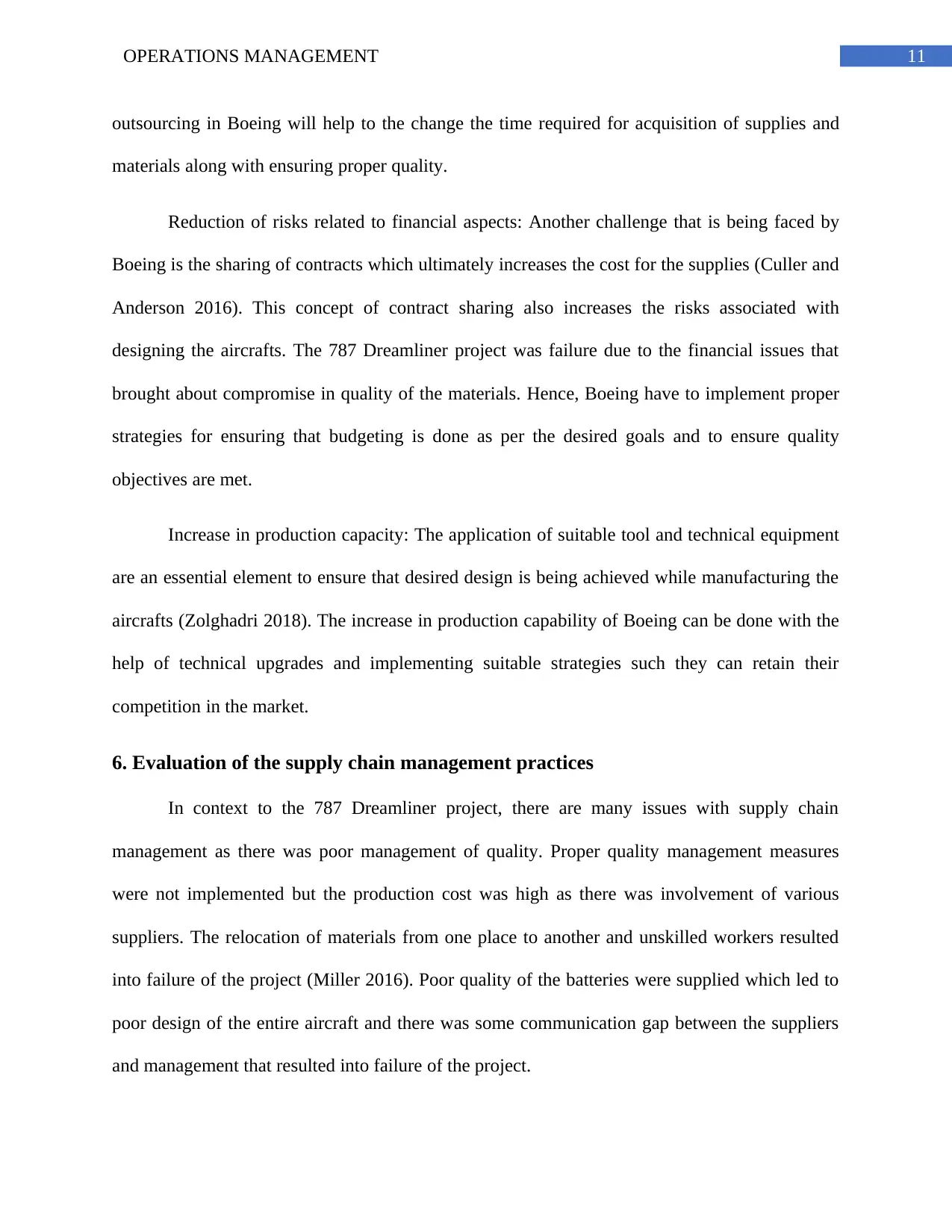
11OPERATIONS MANAGEMENT
outsourcing in Boeing will help to the change the time required for acquisition of supplies and
materials along with ensuring proper quality.
Reduction of risks related to financial aspects: Another challenge that is being faced by
Boeing is the sharing of contracts which ultimately increases the cost for the supplies (Culler and
Anderson 2016). This concept of contract sharing also increases the risks associated with
designing the aircrafts. The 787 Dreamliner project was failure due to the financial issues that
brought about compromise in quality of the materials. Hence, Boeing have to implement proper
strategies for ensuring that budgeting is done as per the desired goals and to ensure quality
objectives are met.
Increase in production capacity: The application of suitable tool and technical equipment
are an essential element to ensure that desired design is being achieved while manufacturing the
aircrafts (Zolghadri 2018). The increase in production capability of Boeing can be done with the
help of technical upgrades and implementing suitable strategies such they can retain their
competition in the market.
6. Evaluation of the supply chain management practices
In context to the 787 Dreamliner project, there are many issues with supply chain
management as there was poor management of quality. Proper quality management measures
were not implemented but the production cost was high as there was involvement of various
suppliers. The relocation of materials from one place to another and unskilled workers resulted
into failure of the project (Miller 2016). Poor quality of the batteries were supplied which led to
poor design of the entire aircraft and there was some communication gap between the suppliers
and management that resulted into failure of the project.
outsourcing in Boeing will help to the change the time required for acquisition of supplies and
materials along with ensuring proper quality.
Reduction of risks related to financial aspects: Another challenge that is being faced by
Boeing is the sharing of contracts which ultimately increases the cost for the supplies (Culler and
Anderson 2016). This concept of contract sharing also increases the risks associated with
designing the aircrafts. The 787 Dreamliner project was failure due to the financial issues that
brought about compromise in quality of the materials. Hence, Boeing have to implement proper
strategies for ensuring that budgeting is done as per the desired goals and to ensure quality
objectives are met.
Increase in production capacity: The application of suitable tool and technical equipment
are an essential element to ensure that desired design is being achieved while manufacturing the
aircrafts (Zolghadri 2018). The increase in production capability of Boeing can be done with the
help of technical upgrades and implementing suitable strategies such they can retain their
competition in the market.
6. Evaluation of the supply chain management practices
In context to the 787 Dreamliner project, there are many issues with supply chain
management as there was poor management of quality. Proper quality management measures
were not implemented but the production cost was high as there was involvement of various
suppliers. The relocation of materials from one place to another and unskilled workers resulted
into failure of the project (Miller 2016). Poor quality of the batteries were supplied which led to
poor design of the entire aircraft and there was some communication gap between the suppliers
and management that resulted into failure of the project.
⊘ This is a preview!⊘
Do you want full access?
Subscribe today to unlock all pages.

Trusted by 1+ million students worldwide
1 out of 27
Related Documents
Your All-in-One AI-Powered Toolkit for Academic Success.
+13062052269
info@desklib.com
Available 24*7 on WhatsApp / Email
![[object Object]](/_next/static/media/star-bottom.7253800d.svg)
Unlock your academic potential
Copyright © 2020–2025 A2Z Services. All Rights Reserved. Developed and managed by ZUCOL.





